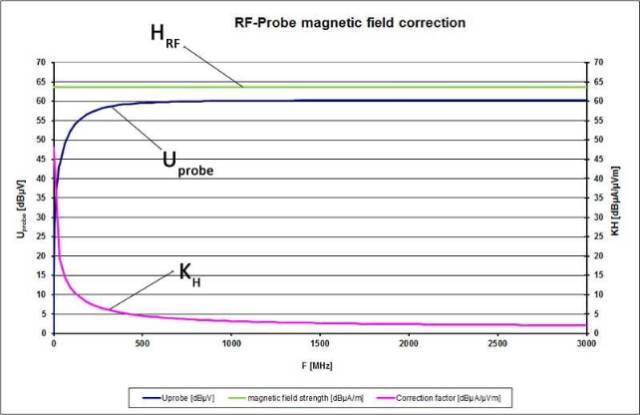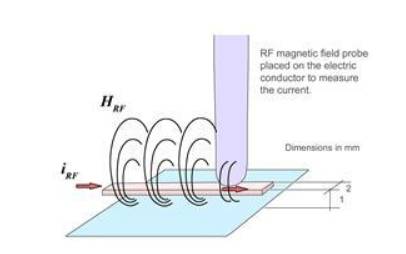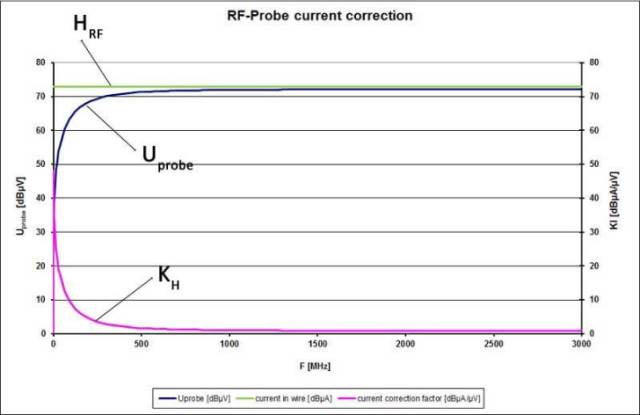The voltage signal output (Uprobe) emitted by the magnetic field probe is separated into a spectrum by the spectrum analyzer. The magnetic field correction factor (KH) is defined as the relationship between the voltage signal and the associated magnetic field (HRF). The magnetic field (HRF) is related to the current (IRF) such that another correction factor is defined based on the current (IRF). 1. Magnetic field correction: From the voltage signal (Uprobe) measured by the magnetic field probe, the magnetic field strength (HRF) in the magnetic field probe coil can be calculated by modifying the formula. In each individual application, the correction factor of the magnetic field probe is independent of the measurement geometry, ie the probe can be manipulated at any distance and angle without any correction errors relative to the conductor (Figure 2), and the results are all around the probe coil. It is the average magnetic field strength (Figure 1). Figure 1 Field strength release in the probe coil (uniform magnetic field) Figure 2 General Test Setup Layout According to the correction factor (KH), calculate the average magnetic field strength according to the following formula: An example of an operational equation is shown in Figure 3: In Figure 3, the magnetic field probe is in a constant magnetic field over the full frequency range. Due to the coupling factor, the voltage induced in the probe depends on the frequency. The coupling coefficient is derived from the measured voltage (Uprobe) and the average magnetic field strength. If the correction factor is added to the measured voltage (Uprobe), the actual magnetic field strength (HRF logarithmic expression) can be obtained. The average magnetic field strength (HRF) can be determined from the measured curve (Uprobe) and the correction factor (KH) using a formula. The result is shown in Figure 3. Figure 3 shows how to calculate the correction factor 2. Current correction: There is a consistent physical correlation between the radio frequency magnetic field (HRF) and the radio frequency current (IRF), the extent of which depends on the geometric parameters of the current conductor layout. Therefore, the current correction factor (K I) needs to be calibrated under the defined reference settings in the test. When the high-frequency current probe is used, only the geometric parameters coincide with the reference settings, and the measured current value (Icorr) is accurately corrected. If there is a deviation in the setting, the current value (Icorr) will also deviate. At this time, the calculated current value (Icorr) can only be a reference value of the strength level, not an accurate measurement value. When testing the correction, refer to the following geometric parameters (Figure 4 and Figure 5): the wire width is required to be 2mm; the wire is 1mm from the grounding system; the magnetic field probe is placed on the wire (see Figure 4). According to the current correction factor (KH), calculate the current value according to the following formula: Figure 4 Settings for the RF-R400-1\RF-R50-1\RF-R3-2\RF-R0.3-3 Near Field Probe Figure 5 Settings for RF-B3-2\RF-B0.3-3\RF-K7-4\RF-U2.5-2\RF-U 5-2 Near Field Probe In this example, a constant current is used over the full frequency range (Figure 6). Through the magnetic field probe, the current becomes a voltage and the probe output voltage (Uprobe) is measured by a spectrum analyzer. The current (logarithm) in the conductor is measured by the voltage waveform output from the probe, plus the frequency-dependent correction factor. In this reference setting, Icorr is the current flowing (dBuA). Figure 6 Example of current correction (green is current dBμA) 72W Medical Adapter,72W Medical Power Supply Adapter,72W Medical Ventilator Adapter,72W Medical Outlet Adapter Shenzhen Longxc Power Supply Co., Ltd , https://www.longxcpower.com





